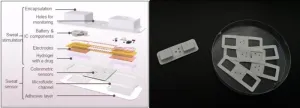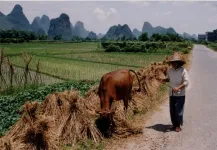(Press-News.org) Sweat contains biomarkers that can monitor various health conditions, from diabetes to genetic disorders. Sweat sampling, unlike blood collection, is preferred by users due to its painless nature. However, to obtain sufficient nutrients or hormones from sweat for testing, intense physical activity was previously required to induce sweat. This method posed challenges for individuals with limited mobility.
Dr. Kim Joohee from the Bionics Research Center at the Korea Institute of Science and Technology (KIST, Director Oh Sangrok) and Professor John A. Rogers from Northwestern University jointly announced the development of a convenient sweat monitoring device that does not require physical activity but delivers drug stimulation through the skin. Unlike previous methods that induced sweat through exercise, this device delivers drugs that stimulate sweat glands through the skin.
The research team developed a flexible device capable of delivering drugs to sweat glands by applying a current to a hydrogel containing drugs. This device, which is small and soft, can be easily attached to the skin. Sweat induced by the drug is collected in microfluidic channels within the device and analyzed for biomarkers using biosensors. This enables the analysis of biomarkers in sweat, reducing the need for cumbersome hospital visits for testing and lowering the risk of biomarker contamination during testing, thereby increasing accuracy.
The device developed by the research team was attached to infants with cystic fibrosis, and the chloride concentration, a biomarker in sweat, was confirmed. The results were consistent with those obtained from traditional analysis methods using sweat collected in hospitals, with an accuracy of over 98%. Additionally, the stability of the device on the skin was ensured by confirming skin temperature and pH values. Since cystic fibrosis mainly manifests during infancy, continuous monitoring of disease progression and physical condition is necessary. With this device, monitoring can be easily done at home, reducing the psychological and physical stress on pediatric patients and their caregivers.
This newly developed device contributes to the expansion of non-invasive disease monitoring technology based on sweat in healthy adults as well. Furthermore, the technology of delivering drugs through the skin can be utilized not only to induce sweat but also to increase the delivery rate of drugs in localized areas such as skin conditions or wounds, thereby accelerating recovery.
Dr. Kim Joohee stated, "Through two years of collaborative research with Northwestern University, we have not only addressed the limitations of existing methods for inducing sweat but also achieved success in clinical research, bringing us one step closer to commercialization." Professor John A. Rogers added, "We plan to conduct large-scale clinical studies and commercialization, including adults, in the future."
###
KIST was established in 1966 as the first government-funded research institute in Korea. KIST now strives to solve national and social challenges and secure growth engines through leading and innovative research. For more information, please visit KIST’s website at https://eng.kist.re.kr/
This research was conducted through KIST's major projects and the Outstanding Young Researcher Program (RS-2023-00211342) supported by the Ministry of Science and ICT (Minister Lee Jong-ho). The research findings were recently published online in the latest issue of the international journal "Biosensors & Bioelectronics" (IF 12.6).
END
Monitoring diseases through sweat becomes accessible to everyone
Successful clinical testing on pediatric patients with cystic fibrosis using a flexible device enabling sweat gland stimulation and simultaneous biosensing. Two-year collaborative research between KIST and Northwestern University
2024-05-28
ELSE PRESS RELEASES FROM THIS DATE:
Mathematical model driven evolutionary therapy dosing exploiting cancer cell plasticity
2024-05-28
Cancer poses significant challenges due to the development of resistance and the likelihood of relapse. Resistance may arise from permanent genetic changes in cancer cells or non-genetic alterations in cancer cell behavior induced by treatment. Standard of care in cancer treatments typically involves administering the maximum tolerated dose of a drug to eradicate drug-sensitive cells effectively. However, this approach often fails in the long term because drug-resistant cancer cells can grow more rapidly when all drug-sensitive cancer ...
Biodiversity in the margins: Merging farmlands affects natural pest control
2024-05-28
A new study published in the Journal of Applied Ecology demonstrates how the diversity and abundance of arthropods decrease when hedgerows and field margins covered by wild grass and flowers are removed.
Researchers from the UK, Netherlands and China studied 20 rice fields in China for six years to see how the changing agricultural landscape affects the diversity and abundance of rice pests and their natural enemies, as well as the effect on rice yield.
Traditional Chinese smallholder fields are irregularly shaped and separated by areas of hedgerows, wild grass, and flowers. Using large-scale machinery in these farmlands is difficult, so there is low agricultural ...
1 in 8 pregnant people have a disability, but significant gaps exist in the provision of accessible care
2024-05-28
Toronto, ON, May 28, 2024 – People with disabilities account for 13% of all pregnancies in Ontario, but a new report shows that this population was more likely to experience pregnancy complications such as emergency department visits, hospitalizations, and preterm birth.
Researchers from ICES, the University of Toronto Scarborough, and the Centre for Addiction and Mental Health (CAMH) have released a landmark report detailing findings from one of the largest studies to date on disability and pregnancy.
Funded by the US National Institutes of Health, the Disability and Pregnancy Study used healthcare ...
Statins associated with decreased risk for CVD and death, even in very old adults
2024-05-27
Embargoed for release until 5:00 p.m. ET on Monday 27 May 2024
Annals of Internal Medicine Tip Sheet
@Annalsofim
Below please find summaries of new articles that will be published in the next issue of Annals of Internal Medicine. The summaries are not intended to substitute for the full articles as a source of information. This information is under strict embargo and by taking it into possession, media representatives are committing to the terms of the embargo not only on their own behalf, but also on behalf of the organization they represent.
----------------------------
1. Statins associated with ...
Climate change is moving tree populations away from the soil fungi that sustain them
2024-05-27
As our planet warms, many species are shifting to different locations as their historical habitats become inhospitable. Trees are no exception – many species’ normal ranges are no longer conducive to their health, but their shift to new areas that could better sustain them has been lagging behind those of other plants and animals. Now, scientists show that the reason for this lag might be found belowground. A study published in PNAS on May X, shows that trees, especially those in the far ...
Secrets of sargassum: Scientists advance knowledge of seaweed causing chaos in the Caribbean and West Africa
2024-05-27
Researchers have been working to track and study floating sargassum, a prolific seaweed swamping Caribbean and West African shorelines, and causing environmental and economic harm.
The stranded seaweed blocks fishing boats; threatens tourism; disrupts turtle nesting sites, reefs and mangroves, and releases toxic gas, which impacts human health and damages electrical equipment.
First reported by Christopher Columbus in the 15th century, floating mats of sargassum have long been present in the North Atlantic. However, since 2011, a floating population has established ...
Bioinformatics approach could help optimize soldiers’ training for improved readiness and recovery
2024-05-27
Of the many perils facing members of the military, injuries incurred in training or on deployment repeatedly sideline elite operators.
“It’s a pervasive problem,” says Dhruv Seshadri, an assistant professor of bioengineering in Lehigh University’s P.C. Rossin College of Engineering and Applied Science. “We’re looking at how we can integrate physiological data, biomechanical data, and subjective assessments to help reduce the risk of these injuries happening in the first place, and when they do happen, how we can use those data to accelerate the soldier’s return to operation.”
Seshadri ...
Earth scientists describe a new kind of volcanic eruption
2024-05-27
No two volcanic eruptions are exactly alike, but scientists think a series of explosive eruptions at Kīlauea volcano fit into a whole new category.
By analyzing the dynamics of 12 back-to-back explosions that happened in 2018, researchers describe a new type of volcanic eruption mechanism. The explosions were driven by sudden pressure increases as the ground collapsed, which blasted plumes of rock fragments and hot gas into the air, much like a classic stomp-rocket toy.
Researchers from the University of Oregon, United States Geological Survey and China’s Sichuan University report their findings in a paper published May 27 in Nature Geoscience.
The ...
Warmer wetter climate predicted to bring societal and ecological impact to the Tibetan Plateau
2024-05-27
While recent reports have stated that more than half the world’s largest lakes, including lakes in the Tibetan plateau, are drying up, a paper in Nature Geoscience today (27/5/24 DOI 10.1038/s41561-024-01446-w ) suggests that, by the end of this century, land-locked lakes on the Tibetan Plateau are set to increase exponentially, resulting in major land loss and related economic, environmental and climatic impacts.
Climate and weather predictions suggest that increased rainfall due to climate change will enlarge these lakes, and see water levels rise by up to 10 metres.
The volume of water caught in these land-locked lakes is estimated to ...
Feeding infants peanut products protects against allergy into adolescence
2024-05-27
Feeding children peanuts regularly from infancy to age five reduced the rate of peanut allergy in adolescence by 71%, even after many years when the children ate or avoided peanut as desired.
The new findings provide conclusive evidence that introducing peanuts into babies’ diets early will achieve long-term prevention of peanut allergy.
Lead investigator Professor Gideon Lack from King’s College London said: “Decades of advice to avoid peanuts has made parents fearful of introducing peanuts at an early age. The evidence is clear that early introduction of peanut in infancy ...
LAST 30 PRESS RELEASES:
Scientists boost cell "powerhouses" to burn more calories
Automatic label checking: The missing step in making reliable medical AI
Low daily alcohol intake linked to 50% heightened mouth cancer risk in India
American Meteorological Society announces Rick Spinrad as 2026 President-Elect
Biomass-based carbon capture spotlighted in newly released global climate webinar recording
Illuminating invisible nano pollutants: advanced bioimaging tracks the full journey of emerging nanoscale contaminants in living systems
How does age affect recovery from spinal cord injury?
Novel AI tool offers prognosis for patients with head and neck cancer
Fathers’ microplastic exposure tied to their children’s metabolic problems
Research validates laboratory model for studying high-grade serous ovarian cancer
SIR 2026 delivers transformative breakthroughs in minimally invasive medicine to improve patient care
Stem Cell Reports most downloaded papers of 2025 highlight the breadth and impact of stem cell research
Oxford-led study estimates NHS spends around 3% of its primary and secondary care budget on the health impacts of heat and cold in England
A researcher’s long quest leads to a smart composite breakthrough
Urban wild bees act as “microbial sensors” of city health.
New study finds where you live affects recovery after a hip fracture
Forecasting the impact of fully automated vehicle adoption on US road traffic injuries
Alcohol-related hospitalizations from 2016 to 2022
Semaglutide and hospitalizations in patients with obesity and established cardiovascular disease
Researchers ‘listen in’ to embryo-mother interactions during implantation using a culture system replicating the womb lining
How changing your diet could help save the world
How to make AI truly scalable and reliable for real-time traffic assignment?
Beyond fragmented markets: A new framework for efficient and stable ride-pooling
Can shape priors make road perception more reliable for autonomous driving?
AI tracks nearly 100 years of aging research, revealing key trends and gaps
Innovative techniques enable Italy’s first imaging of individual trapped atoms
KIER successfully develops Korea-made “calibration thermoelectric module” for measuring thermoelectric device performance
Diversifying US Midwest farming for stability and resilience
Emphasizing immigrants’ deservingness shifts attitudes
Japanese eels, climate change, and river temperature
[Press-News.org] Monitoring diseases through sweat becomes accessible to everyoneSuccessful clinical testing on pediatric patients with cystic fibrosis using a flexible device enabling sweat gland stimulation and simultaneous biosensing. Two-year collaborative research between KIST and Northwestern University







